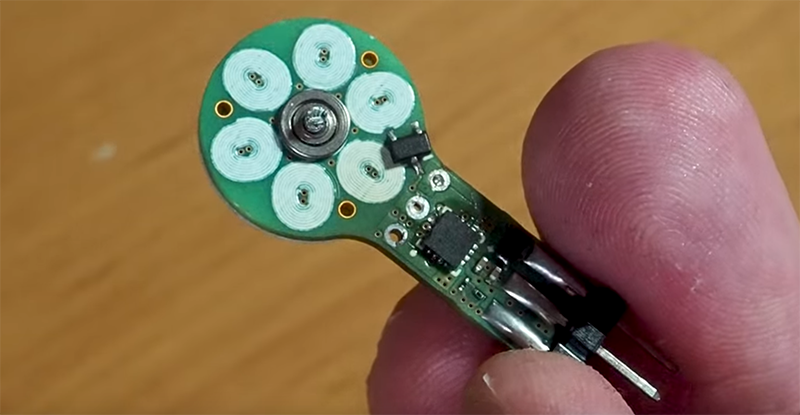One of the more interesting hacks we’ve seen this year is [Carl]’s experimentations with making motors out of PCBs. Honestly, it’s surprising no one has done this before — a brushless motor is just some coils of wire and a few magnets; anyone can turn some coils into traces and make a 3D print that will hold a few magnets. This latest advancement is something else entirely. It’s a motor and an electronic speed controller all in one.
This project is a continuation of [Carl]’s PCB motor project, which started with him routing coils for a brushless motor as traces in a circuit board. Previously, we’ve seen [Carl]’s motor spinning on its own with the help of a small hobby ESC / motor controller meant for model planes and drones. This time, we’ve got something different. It’s an entire controller and motor, integrated into one single PCB.
This is a very, very small motor and ESC combo. The motor driver is a 3x3mm QFN package, and most of the other components are 0201. The main parts are a very tiny triple half-bridge motor driver and a PIC16F microcontroller. This PIC reads a hall sensor to detect the speed of the motor, and with just three pins — power, ground, and a PWM pin — this motor can spin at a set speed.
The future goals of this project are to make it work just like any other hobby ESC — just plug it into a servo controller and let ‘er rip. Since this motor with an integrated PCB requires only three connections, we’re looking at a great tool to add motion and rotation to any project. It’s fantastic, and we can’t wait to see something like this in robots, toys, and other home goods.

















Is HaD going to celebrate Mole Day?
https://www.acs.org/content/acs/en/education/students/highschool/chemistryclubs/activities/mole-day.html
I would say they are too busy auto-celebrating their intergalactic contests, prizes, medals… sponsors.
How is it related to the article?
It isn’t, much like most of Ren’s comments.
“it’s surprising no one has done this before”
People have been doing this for years. Just patent-searching “PCB Stator” reveals a huge number of results:
https://patents.google.com/?q=pcb&q=stator&oq=pcb+stator
The old ServoDisc “printed” brushed motors were essentially this as well
A variety of other examples:
http://coreoutdoorpower.com/technology/
http://www.e-circuitmotors.com/pg/company/technology
https://ieeexplore.ieee.org/abstract/document/5257240
https://ieeexplore.ieee.org/abstract/document/6316334
https://rpk.lcsr.jhu.edu/wp-content/uploads/2014/08/DETC2011-48602.pdf
https://geekshavefeelings.com/posts/delicious-axial-flux-flapjack
I’ve seen 3.5″ floppy drive motors with the coils made in the PCB while the rotor has a plastic ferrite composite ring that’s magnetized in zones.
Again and again reading stupid comments with adoring floppy drive. This coil is not for moving magnets, it is for measuring speed !!!!! Try short circuit this coil and motor start on crazy high speed !!!!
Can you please explain what you think is the coil that drives the motor than? I only see these printed coils and there must be something that drives the motor…
this is typical motor https://commons.wikimedia.org/wiki/File:Floppy_drive_spindle_motor_stator.jpg traces on PCB are only feedback, if you have another motor please take picture
I can’t wait until he achieves his end-goal: a PCB drone.
Ooooh drone business card. You could have them distribute themselves!
You mean like this: https://www.bitcraze.io/crazyflie-2/
But with PCB based motors as well..
Yup. I see an ESP-based drone with meshing.
It’s been done plenty before, here’s a post from 2011 https://endless-sphere.com/forums/viewtopic.php?t=21127&start=225,
I’ve seen them much earlier than that.
The problem is that they suck from and efficiency standpoint due to the copper fill factor being poor and eddy currents being high. There are niche low power and low speed applications where they might make sense though,
Flip-dots display ?
I’m actually considering a watch-like application that would require low power, low speed and high efficiency (at low torque and low speed), I’m curious how a tiny PCB motor would stack up.
Nice fingerprint photo!
Please add your complete DNA zipfile in the comments too.